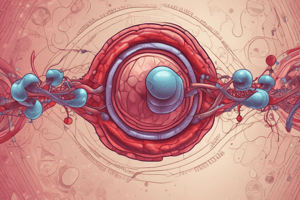Podcast
Questions and Answers
What is the primary cause of anemia in Thalassemia?
What is the primary cause of anemia in Thalassemia?
- Increased levels of bilirubin
- Excess production of iron
- Inadequate production of hemoglobin due to globin chain synthesis issues (correct)
- Total absence of hemoglobin
Which type of Thalassemia is characterized by point mutations on Chromosome 11?
Which type of Thalassemia is characterized by point mutations on Chromosome 11?
- Thalassemia Major
- Alpha Thalassemia
- Beta Thalassemia (correct)
- Thalassemia Minor
Which clinical feature is specifically associated with Thalassemia Major in infants?
Which clinical feature is specifically associated with Thalassemia Major in infants?
- Delayed menarche
- Skeletal deformities
- Mild pallor without jaundice
- Failure to thrive and gross motor delay (correct)
What is the result of the relative excess of alpha chains in Thalassemia?
What is the result of the relative excess of alpha chains in Thalassemia?
Which of the following denotes the condition of transfusion-required therapy typically due to severe anemia?
Which of the following denotes the condition of transfusion-required therapy typically due to severe anemia?
What hematological finding is typically observed in Thalassemia syndromes?
What hematological finding is typically observed in Thalassemia syndromes?
Which complication is linked to the accumulation of iron in Thalassemia patients?
Which complication is linked to the accumulation of iron in Thalassemia patients?
What is the typical presentation of Thalassemia Minor?
What is the typical presentation of Thalassemia Minor?
What is a common skeletal change seen in patients with Thalassemia Major?
What is a common skeletal change seen in patients with Thalassemia Major?
Which of the following infections is particularly a risk in Thalassemia patients?
Which of the following infections is particularly a risk in Thalassemia patients?
What hormonal impact is associated with pituitary iron deposition in Thalassemia patients?
What hormonal impact is associated with pituitary iron deposition in Thalassemia patients?
Which outcome results from chronic hemolysis in Thalassemia patients?
Which outcome results from chronic hemolysis in Thalassemia patients?
What is a potential consequence of ineffective erythropoiesis in Thalassemia?
What is a potential consequence of ineffective erythropoiesis in Thalassemia?
Which feature is indicative of hypersplenism in Thalassemia patients?
Which feature is indicative of hypersplenism in Thalassemia patients?
Flashcards are hidden until you start studying
Study Notes
Thalassemia
- Also known as: Von Jaksch Anemia, Cooley's Anemia
- Characterized by reduced or absent synthesis of globin chains in hemoglobin
- Most common single gene disorder
- Inherited Autosomal Recessively
- Beta Thalassemia: Point mutations on Chromosome 11
- If beta chain is suppressed, adult Hb is suppressed
- Alpha Thalassemia: Gene deletions on Chromosome 16
- If alpha chain synthesis is suppressed, levels of all 3 normal Hbs (A, A2, F) are reduced
Pathophysiology
- Reduced beta chain synthesis leads to excess alpha chains
- Alpha tetramers form aggregates and precipitate in red cells
- This causes premature destruction of maturing erythroblasts in the marrow (ineffective erythropoiesis) or peripherally (hemolysis)
- Anemia results from inadequate Hb A, causing tissue hypoxia
- Increased EPO production stimulates erythropoiesis in the marrow and sometimes extramedullary, expanding the medullary cavity of bones
Effects of Marrow Expansion
- Pathological fractures due to cortical thinning
- Deformities of the skull and face
- Sinus and middle ear infection due to ineffective drainage
- Folate deficiency
- Hypermetabolic state -> fever, wasting
- Increased iron absorption from the intestine.
Hepatomegaly
- Extramedullary erythropoiesis
- Iron released from breakdown of endogenous or transfused RBCs is not utilized for hemoglobin synthesis, leading to hemosiderosis
- Hemochromatosis
- Infections: Transfusion related (Hepatitis B, C, and HIV)
- Chronic active hepatitis
Splenomegaly
- Extramedullary hematopoiesis
- Work hypertrophy due to constant hemolysis
- Hypersplenism (progressive splenomegaly)
- Jaundice
- Unconjugated hyperbilirubinemia: Hemolysis
- Hepatitis: Transfusion, hemochromatosis
- Gallbladder stones: Obstructive jaundice
- Cholangitis
Infections
- Poor nutrition
- Increased iron in the body
- Blockage of the monocyte-macrophage system
- Hypersplenism: Leukopenia
- Infections associated with transfusions
Iron Accumulation
- Deposition in the pituitary (Endocrine disturbance): Short stature, delayed puberty, poor secondary sexual characteristics
- Hemochromatosis: Cirrhosis of the liver
- Cardiomyopathy (cardiac hemosiderosis): Cardiac failure, sterile pericarditis, arrhythmias, heart block
- Deposition in the pancreas: Diabetes mellitus
- Lungs: Restrictive lung defects
- Adrenal insufficiency
- Hypothyroidism, Hypoparathyroidism
- Increased susceptibility to infections (iron favors bacterial growth), especially Yersinia infections
Clinical Features (Thalassemia Major)
Infants
- Age of presentation: 6-9 months (HbF replaced by HbA)
- Progressive pallor and jaundice
- Cardiac failure
- Failure to thrive, gross motor delay
- Feeding problems
- Bouts of fever and diarrhea
- Hepatosplenomegaly
Childhood
- Growth retardation
- Severe anemia-cardiac dilatation
- Transfusion-dependent
- Icterus
- Changes in skeletal system
Skeletal Changes
- Chipmunk Facies (Hemolytic Facies)
- Frontal bossing, maxillary hypertrophy, depression of nasal bridge, malocclusion of teeth
- Paravertebral Masses
- Broad expansion of ribs at vertebral attachment
- Paraparesis
- Pathological Fractures
- Cortical thinning
- Increased porosity of long bones
- Delayed Pneumatization of the Sinuses
- Premature fusion of the Epiphyses: Short stature
Other Clinical Features
- Delayed menarche
- Gallstones, Leg ulcers
- Pericarditis
- Diabetes/Cirrhosis of the Liver
- Evidence of Hypersplenism
Clinical Features (Thalassemia Intermedia)
- Moderate pallor, usually maintains Hb >6gm%
- Anemia worsens with pregnancy and infections (erythroid stress)
- Less transfusion dependent
- Skeletal changes present, progressive splenomegaly
- Growth retardation
- Longer survival than Thalassemia major
Clinical Features (Thalassemia Minor)
- Usually asymptomatic
- Mild pallor, no jaundice
- No growth retardation, no skeletal abnormalities, no splenomegaly
- May present as Iron Deficiency Anemia
Studying That Suits You
Use AI to generate personalized quizzes and flashcards to suit your learning preferences.




